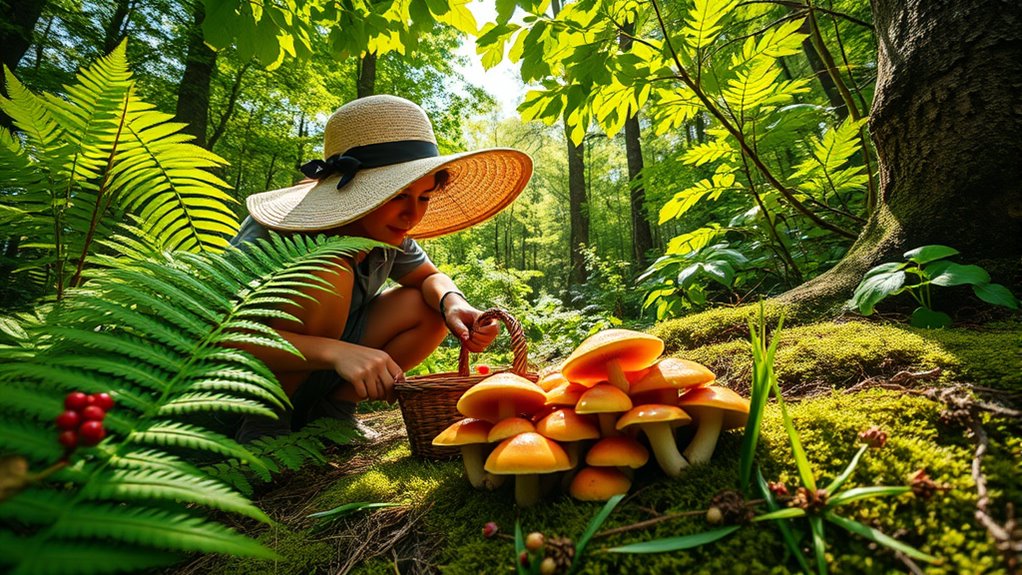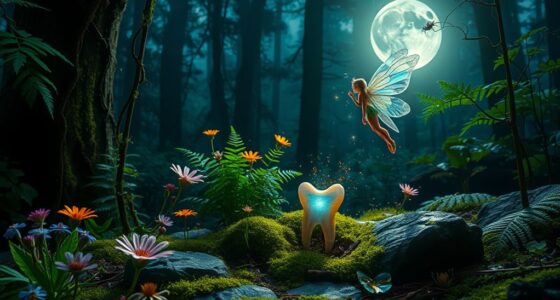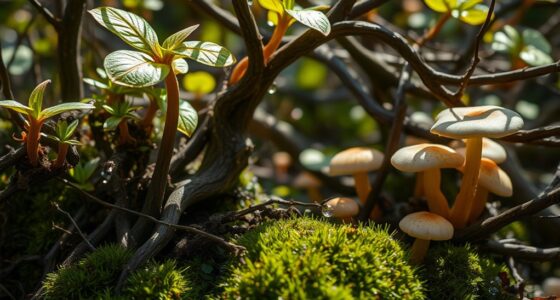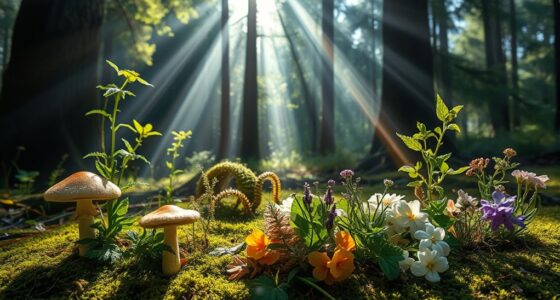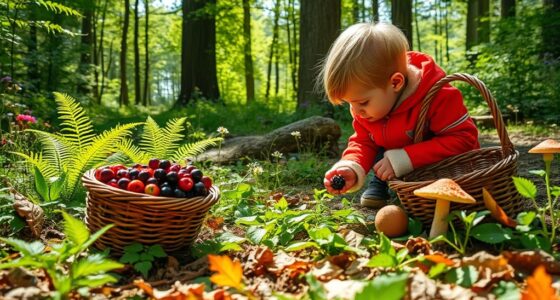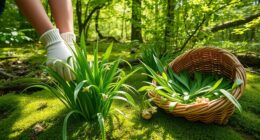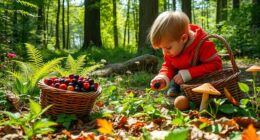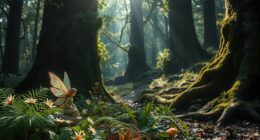Modern foraging stories show how urban dwellers are reconnecting with nature by sustainably collecting wild plants, fungi, and fruits in city parks and local ecosystems. People are turning neglected areas into food sources, following eco-friendly practices, and using apps to identify edible resources. These adventures blend tradition with innovation, emphasizing safety, respect for regulations, and community sharing. Keep exploring these inspiring journeys to discover more about how modern foraging is transforming city life.
Key Takeaways
- Urban foragers share stories of transforming city spaces into edible landscapes, highlighting sustainable harvesting in local ecosystems.
- Personal adventures often involve guided walks and expert identification to ensure safety and accurate plant recognition.
- Tales include gathering wild fungi, fruits, and herbs from parks, roadsides, and community food forests.
- Foraging experiences emphasize respect for regulations, ethical practices, and ecosystem health to ensure sustainability.
- Digital tools and community events facilitate knowledge sharing, safety, and conservation in modern foraging journeys.
Rediscovering Old Traditions in Urban Settings

Rediscovering old foraging traditions in urban settings offers a meaningful way to reconnect with nature and sustainable practices. For thousands of years, humans gathered wild plants, fruits, and fungi for food and medicine. Recently, the COVID-19 pandemic and rising food costs have sparked new interest in urban foraging.
You can transform city spaces into productive environments by planting edible plants instead of just ornamental ones, challenging typical urban design. Initiatives like food forests and community-led efforts turn neglected areas into valuable resources, helping reduce food waste and improve food security.
As you explore city parks, gardens, or roadsides, you’ll discover abundant wild edibles, from trees to fungi. This practice encourages a deeper relationship with local ecosystems and promotes a sustainable way to nourish ourselves within urban landscapes.
Sustainable Practices That Protect Biodiversity

Embracing sustainable foraging practices helps protect the rich biodiversity that sustains urban ecosystems. You should always follow leave-no-trace principles, guaranteeing you don’t leave behind waste or damage the environment.
Respect local regulations and seek permission before foraging on private or public lands to support ethical land use. Proper waste disposal and avoiding overharvesting are crucial to maintaining ecosystem balance and preventing harm to habitats. Incorporating ethical foraging techniques ensures that natural resources are preserved for future generations. Developing digital literacy programs can also aid in educating foragers about sustainable practices.
Always obtain permission and follow regulations to ensure ethical foraging and protect our ecosystems.
Recognize the importance of indigenous peoples’ land stewardship and incorporate their legacy into your practices. Using established trails and observing wildlife from a distance minimizes disturbance. Monitoring local biodiversity helps identify sensitive species and areas that require extra protection. Additionally, understanding the shelf life of foraged products can help prevent waste and ensure safety in consumption.
Additionally, participate in community efforts like citizen science to contribute to conservation. By practicing responsible foraging, you help preserve habitats, promote biodiversity, and ensure natural resources remain available for future generations. Incorporating textile art techniques into your craft can also foster a deeper connection to nature and sustainability.

Managing the risks of modern foraging requires you to prioritize safety and awareness at every step. Start by learning from experts, consulting knowledgeable mentors, and using guidebooks or online resources for accurate identification.
Participating in guided walks helps you gain local knowledge and practice multiple source verification. Always ask questions if unsure about a plant’s identity.
When choosing foraging locations, avoid polluted areas like industrial zones and roadways, and seek permissions for private land. Be mindful of wildlife and environmental conditions, ensuring you’re in safe zones free from chemicals. Additionally, understanding the color accuracy of equipment can significantly improve your identification process and overall safety during foraging activities.
Testing new plants with small quantities first, and get expert confirmation before consumption. Utilizing proper safety gear enhances your protection from potential hazards during foraging. Carry essential gear, stay alert, and understand local laws to prevent accidents and ensure a safe, responsible foraging experience. Remember, being aware of environmental conditions is crucial for avoiding dangerous weather or terrain that could compromise your safety.
Furthermore, being familiar with newborn safety guidelines can help you better prepare for emergencies or unexpected situations during outdoor activities. Understanding the cultural significance of certain plants can also guide ethical foraging practices and respect for local traditions.
Inspiring Community Initiatives and Shared Knowledge
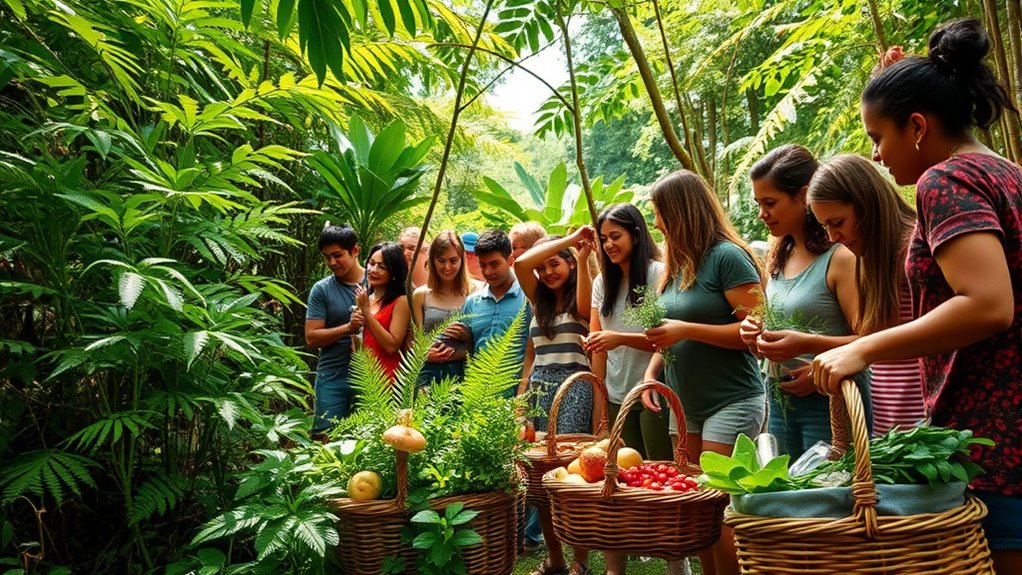
Community initiatives and shared knowledge play an essential role in expanding and sustaining the practice of foraging. Programs like Falling Fruit encourage you to spot and harvest edible plants in urban environments, turning cities into food sources. Additionally, understanding the importance of ecosystem health helps ensure sustainable harvesting practices that protect native plant populations. Energy-efficient options in tools and community programs help reduce environmental impact while promoting sustainable foraging methods. Community-supported foraging plans aim to recognize foraging as part of urban food systems, designating areas for public gathering and harvesting. Educational events such as foraging walks and classes teach you sustainable practices and identify native foods. Online forums like Forage Maryland connect enthusiasts, allowing you to share tips, resources, and discoveries. Collaborations between nonprofits, universities, and farms promote awareness and engagement through workshops and public events. Emphasizing regulatory compliance helps ensure that foraging activities adhere to legal standards and protect natural areas. Implementing sustainable harvesting techniques further supports ecological balance and resource renewal. Promoting awareness of nutrient-rich ingredients can enhance the nutritional value of foraged foods and encourage healthier eating habits. These efforts help foster a vibrant community, preserve cultural traditions, and support ecological health—all crucial for the growth of modern foraging.
Technological Tools Transforming Foraging Experiences
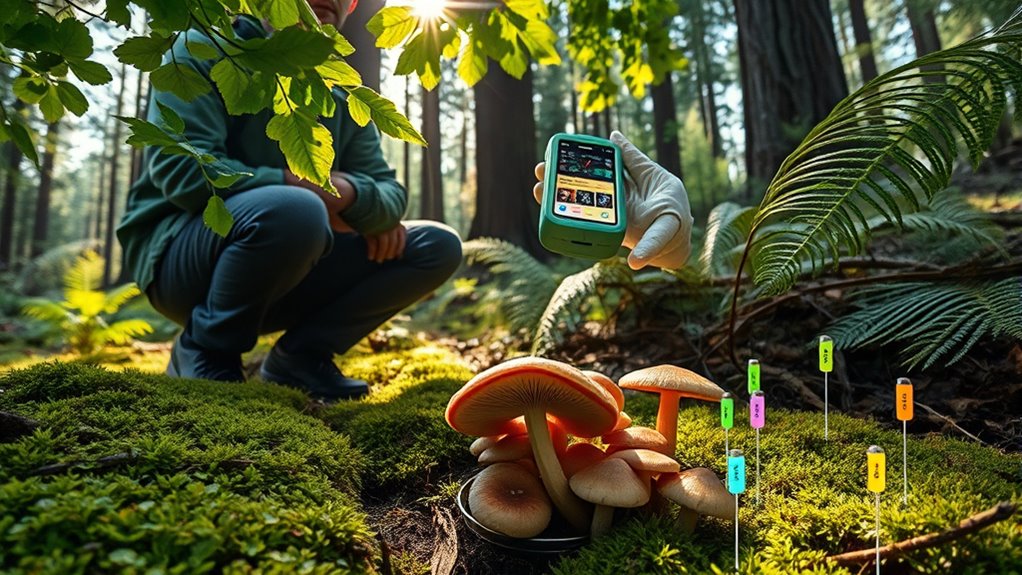
Technological tools are revolutionizing the way foragers identify, log, and share information about wild foods. AI-powered apps can help you recognize plants through images or videos, but they often have accuracy rates below 50%, so expert verification remains essential. Incorporating visualization techniques can further enhance your ability to accurately identify and connect with the natural environment. Visual and video guidance enhances learning, with apps requesting additional photos for better identification. Digital platforms like foraging apps and community forums enable you to track locations, share experiences, and access educational resources. Smartphone cameras, GPS devices, and data logging tools help you record precise foraging spots and environmental conditions, improving safety and efficiency. Electronic field guides and sensors monitor habitat factors, supporting suitable foraging times and understanding foraging range within local ecosystems. Utilizing self-reflection can help you develop a deeper connection and understanding of your foraging experiences, fostering more mindful interactions with nature. Exploring local ecosystems can provide insights into seasonal variations and sustainable foraging practices. Additionally, awareness of home heating solutions can inspire foragers to consider sustainable practices when modifying their environments to support local ecosystems.
Frequently Asked Questions
How Do I Identify Edible Versus Toxic Plants Accurately?
To identify edible versus toxic plants accurately, you need to carefully observe physical features like leaf structure, flower patterns, and seed color.
Use reliable resources like field guides, and consider consulting experts.
Always perform the universal edibility test cautiously, starting with small bites and monitoring reactions.
Avoid areas with chemicals or pesticides, and never rely solely on smartphone apps.
Your safety depends on proper identification and cautious testing.
What Permits or Legal Permissions Are Needed for Urban Foraging?
Think of urban foraging as exploring a map filled with hidden treasures. Usually, you don’t need permits on public land, but check local laws first—some areas may have restrictions or protected species.
For private property, ask landowners for permission. Use resources like FallingFruit.org and local guides to stay within legal boundaries.
Always verify ownership and regulations, ensuring your foraging journey stays safe, legal, and respectful of the environment.
How Can I Contribute to Local Conservation Through Foraging?
You can contribute to local conservation by practicing sustainable foraging. Always harvest mindfully, taking only what you need, and follow local regulations to protect vulnerable species.
Educate yourself about invasive and abundant plants to help maintain ecosystem balance. Engage with your community to promote responsible foraging and conservation efforts.
What Are Common Mistakes Beginners Make When Foraging?
Imagine mistaking wild garlic for a toxic lookalike. As a beginner, you often rush to identify plants without checking every feature, risking poisoning.
Common mistakes include rushing into foraging, relying on poor guides, or harvesting in contaminated areas. You might also overestimate your skills, leading to misidentification or unsafe consumption.
To stay safe, focus on learning a few easy, unmistakable plants thoroughly before expanding your foraging repertoire.
How Do Cultural Traditions Influence Modern Foraging Practices?
You see, cultural traditions shape modern foraging by passing down essential knowledge about safe and nutritious wild plants. They inspire practices rooted in sustainability, connecting you to heritage and nature.
These traditions encourage using specific resources responsibly, whether in rural or urban settings, fostering a sense of community and cultural identity. By embracing these customs, you contribute to preserving biodiversity and maintaining ecological balance, blending tradition with contemporary foraging methods.
Conclusion
As you embrace modern foraging, remember that over 60% of wild edible plants are threatened by habitat loss. By practicing sustainable foraging and sharing knowledge, you help protect biodiversity and guarantee these traditions thrive. With the right safety tips and tech tools, your adventures become safer and more rewarding. Every forager’s mindful efforts make a real difference—preserving nature’s bounty for generations to come.

